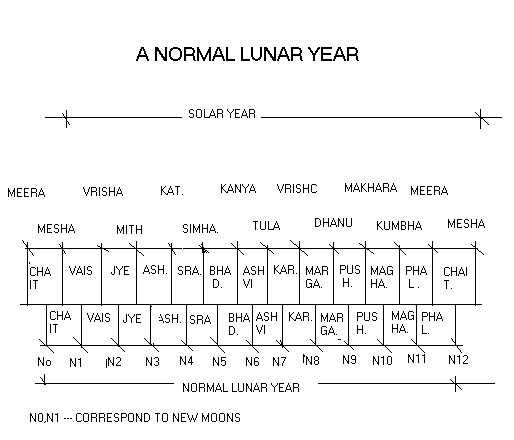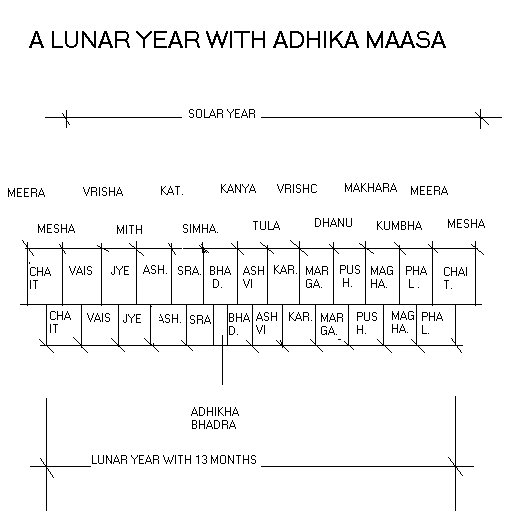
Adhika maasa and Kshaya maasa:
We have seen that a lunar year consists of 12 lunar months. It may so happen that a lunar month is completely contained in a solar month or, a solar month in a lunar month. Absurd!!! is it?? NO. Lets make sense out of it. But before that we'll finish our definition. In the former, the lunar month is called Adhika maasa and in the later, the lunar month is called Kshaya maasa. Now, a lunar month ( 29. ... days) fitting into a solar month definitely and obviously makes sense. At the same time it should not be forgotten that the Sun doesn't revolve uniformly in its ecliptic. So some solar months have less than 30 days (like Feb having 28 or 29 days). And so a lunar month completely fitting into such a solar month, its once in a blue moon !!! //( Whats a blue moon???) Actually it ( Kshaya maasa) occurs normally once in 141 years but occationally after a span of just 19 years ! In a lunar year with a Kshaya maasa there will always be two Adhika maasas, one before and the other after the Kshaya maasa. An Adhika maasa occurs after 33 months. Can you guess why? //due to the 10. ... days per year lag of the lunar year with respect to the solar year//
Thats it, but if you want technical stuff continue reading...
Adhika maasa is a lunar month that occurs between two solar sankrantis. In other
words there are two amavasyas in one solar month. Such a lunar month is given
the name of solar month with two amavasyas. The next lunar month is assigned
a name in the sequencial order as thought there was no Adhika maasa. Beware,
Adhika maasas are generally considered inauspicious !

Adhika maasa and Kshaya
maasa:
We have seen that a lunar year consists of 12 lunar months. It may so happen that a lunar month is completely contained in a solar month or a solar month in a lunar month. Absurd!!! is it? NO. Let's make sense out of it. But before that we'll finish our definition.
When the lunar month is completely contained in a solar month, that lunar month is called Adhika maasa and when the solar month is completely contained in a lunar month, that lunar month is called Kshaya maasa.
Adhika maasa is a lunar month that occurs between two solar sankrantis. In
other words there are two amavasyas in one solar month. Such a lunar month is
given the name of the solar month with the two amavasyas. The next lunar month
is assigned a name in the sequential order as though there was no Adhika maasa.Adhka maasa are generally considered to be inauspicious.
Also, note that, kshaya maasa is a lunar month in which there are two solar
sankrantis.
Now, a lunar month (29.530588 days) fitting into a solar month (approx. 30 days), definitely and obviously makes sense. At the same time, it should not be forgotten that the Sun doesn't revolve uniformly in its ecliptic. So some solar months have less than 30 days (like Feb having 28 or 29 days). Therefore a Solar month completely fitting into a Lunar month happens once in a blue moon! (ya, that is very rare). Normally, it (Kshaya maasa) occurs once in 141 years but occasionally after a span of just 19 years!
In a lunar year with a Kshaya maasa there will always be two Adhika maasas, one before and the other after the Kshaya maasa. An Adhika maasa occurs after 33 months. Can you guess why? [Hint : due to the 10 days (approx.) per year lag of the lunar year with respect to the solar year]
The following diagram will show the relation between the Solar month and the Lunar months and when an Adhhika masa will come.

 In the diagram, the top
row lists all the solar months and the bottom row lists all the Lunar months. In
the solar month of Bhadrapada, there are two amavasyas. So an adhika maasa is
introduced. This is given the same name as Bhadrapada. The Lunar month following
this is a normal month and it is also called as Bhadrapada.
Back
In the diagram, the top
row lists all the solar months and the bottom row lists all the Lunar months. In
the solar month of Bhadrapada, there are two amavasyas. So an adhika maasa is
introduced. This is given the same name as Bhadrapada. The Lunar month following
this is a normal month and it is also called as Bhadrapada.
Back